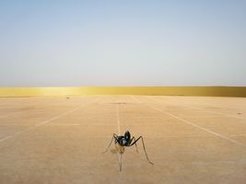
Odor-Guided Behavior
The insect-behavior group investigates how odors affect the behavior of animals as different as vinegar flies, sphingid moths, and desert ants. We are mainly interested in the valence of odors, i.e. whether and why an odor has a positive or negative meaning for an animal. We try to understand the evolutionary and ecological logic by which an insect decodes its chemical environment. Regarding Drosophila, we have identified many ecologically relevant substances (e.g. sex, food, and enemy odors), how they are detected by the fly’s nose, where they become processed in the brain, and – most importantly – in which way they affect the flies’ behaviour. In flies, moths and ants we try to understand the basic principles of olfaction using three approaches:
1. Evolutionary approach

The vinegar fly Drosophila melanogaster feeds, mates, and oviposits on rotten fruits. Many of the fly’s behaviors are governed by fruit- and yeast-derived odors. Dedicated neuronal circuits detect these odors and control the behavior. However, close relatives of the vinegar fly live on as different habitats as animal feces, green leaves, or unripe fruits (Keesey et al. J.Chem.Ecol. 2015, Dweck et al. PNAS 2015). What changes in the olfactory system make those flies prefer so different odors? New techniques for targeting genomes of non-model organism (e.g CRSIPR/Cas) allow us to compare the neuronal circuits of closely related species that drastically differ in their olfactory preferences.
feeds, mates, and oviposits on rotten fruits. Many of the fly’s behaviors are governed by fruit- and yeast-derived odors. Dedicated neuronal circuits detect these odors and control the behavior. However, close relatives of the vinegar fly live on as different habitats as animal feces, green leaves, or unripe fruits (Keesey et al. J.Chem.Ecol. 2015, Dweck et al. PNAS 2015). What changes in the olfactory system make those flies prefer so different odors? New techniques for targeting genomes of non-model organism (e.g CRSIPR/Cas) allow us to compare the neuronal circuits of closely related species that drastically differ in their olfactory preferences.
We recently identified the first Drosophila pheromone that enhances mating (Dweck et al. PNAS 2015) and could show that flies distribute these pheromones in their feces (Keesey et al. J.Chem.Ecol. 2016). We are currently investigating the diversity of sex and aggregation pheromones in several other Drosophila species.
2. Neurophysiological approach
Insects and other animals often need to decide whether or not to approach an odor source, be it food or a potential mate. As this behavior is governed by the brain, we are investigating potential correlations of brain activity and the insect’s behavior. Based on spatially segregated activity patterns in the first olfactory processing center, the antennal lobe, we could predict, whether an odorant was attractive or repellent to the fly (Knaden et al. Cell reports 2012). Obviously, like in humans, specific regions of the insect brain are dedicated to process attractive and repellent olfactory information. Are those regions and their function conserved in other Drosophila species or even in an insect with a complete different life history like the sphingid moth Manduca sexta?
We recently could show that the moth M. sexta, which – like a humming bird – forages in flight, already from distance decides, whether a flower is worth a visit or not. The decision is based on a cost-benefit analysis (“how easily can I reach the nectar, and how many calories do I gain?”), but is also based on an innate preference for the odor of those flowers that promise the best profit (Haverkamp et al. Nature Communications 2016). Furthermore, we found a nose on the tip of the moth’s tongue that informs the animal about the current value of a flower. E.g. a flower that has recently been visited does not contain a lot of nectar (Haverkamp et al. eLife 2016). Having identified two olfactory sensilla at the tip of the proboscis that are responsible for this behavior, we are now screening the full proboscis for its sensorial equipment.
3. Ethological approach
Our main target is to understand olfactory circuits that govern insect behavior. Therefore, we need assays that help us to describe and quantify those behaviors.
For the different questions we have established specific bioassays, like simple trap assays, wind tunnels, courtship assays and an automated high-throughput behavioral paradigm for vinegar flies. We are currently establishing two techniques:
1. behavioral assays for tethered flying flies that allow to analyze behavior and brain activity in parallel.
2. tracking systems for freely moving moths to get a better insight into the functional range of pheromone and flower plumes.
Regarding insect behavior, the desert ant Cataglyphis fortis definitely has become an outstanding model. It is known for its visually guided navigation. However, we could already establish that in addition to visual cues the ants use olfactory cues for many navigational purposes (e.g. targeting a food source or the nest link Bühlmann et al. Current Biology 2014 or the nest link Bühlmann et al. Current Biology 2012). Path integration controls nest-plume following in desert ants. Current Biology, 22, 645-649, use of olfactory landmarks Bühlmann et al. Animal Behaviour 2015, for a review see Knaden et al. Annual Reviews of Entomology 2016). We are currently testing the learning capacity of the ants’ olfactory memory. How many learned odors can they remember and after how many days does memory vanish? All experiments with desert ants are done at our field site in Tunisia during the summer months.
Interested to join us?
If you are interested to join us, please contact me!
